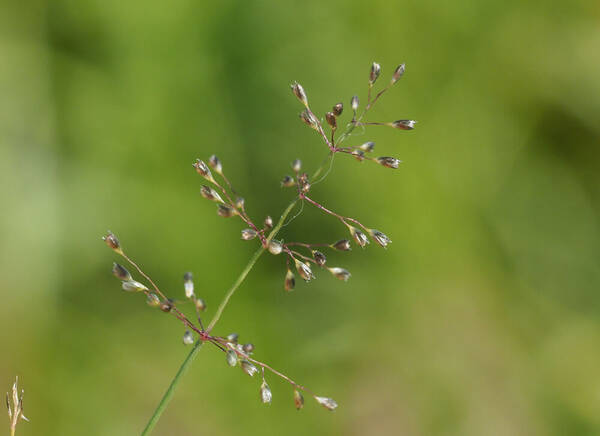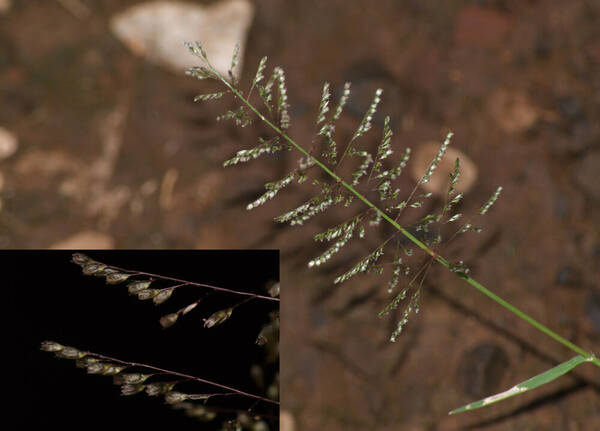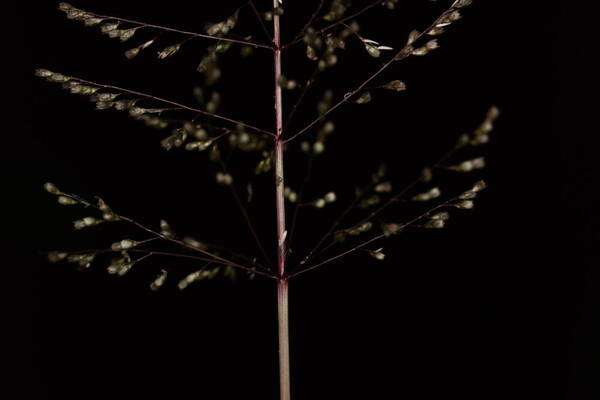Info
Subfamily: Chloridoideae
Genus etymology: Sporobolus = "seed thrower" referring to the seed being ejected from the pericarp
Species etymology: coromandelianus = from the Coromandel region in south-eastern India
Photosynthetic type: C4 (warm season)
Nativity: naturalized - accidental
First recorded in Hawaiʻi: 2022
Map

Inflorescence










Plant

Habit



Spikelets






Description
Tufted annual; culms 7–20 cm. high, erect or ascending. Leaf-blades broadly linear, 2–10 cm. long, 2–4 mm. wide, the margins scabrid or with a few long stiff hairs near the base. Panicle ovate, 2–8 cm. long; primary branches in whorls, spreading horizontally soon after emergence from the uppermost leaf-sheath. Spikelets 1–1.4 mm. long, glabrous or scaberulous, greyish green; lower glume a little oblong scale, 0.1–0.5 mm. long; upper glume oblong-elliptic, as long as the spikelet; lemma similar, but a little shorter; anthers 3, 0.2–0.3 mm. long. Grain obovate, 0.7–0.8 mm. long.
(Description source: Clayton, W.D. 1970. Flora of Tropical East Africa. Gramineae (Part 1). Crown Agents for Oversea Governments and Administrations, London. 176 pp. )
Annual up to 20 cm high; leaves flat, 2–4 mm wide. Panicle ovate, 2–8 cm long; primary branches in whorls, the lowest never barren. Spikelets 1–1.4 mm long; lower glume oblong, 0.1–0.5 mm long; upper glume oblong-elliptic, as long as the spikelet; lemma similar to the upper glume but a little shorter; anthers 3, 0.2–0.3 mm long. Grain obovate, 0.7–0.8 mm long.
(Description source: Cope, T.A, (1995) Flora Somalia, Vol 4. Royal Botanical Gardens, Kew, London. 312 pp. )
Caespitose annual; culms up to 25 cm tall, erect or ascending, branched or unbranched; leaf sheaths chartaceous, usually glabrous, sometimes with tubercle-based hairs near the margins above, lightly compressed; leaf laminas 2–10 cm × 2–4 mm, flat, glabrous or scattered tuberculate-pilose on the surface, scabrid on the margins or with a few long stiff tubercle-based hairs below, acute or subacute at the apex.Panicle 2–8 cm long, ovate; branches in a succession of whorls, smooth, with numerous elongated viscid glandular patches, the spikelets 2–3 on secondary branchlets, these ± confined to the distal part of the primary branches.Spikelets (1)1.2–1.4(1.6) mm long, greyish-green; inferior glume 1/4–1/3 the length of the spikelet, oblong, nerveless, glabrous, obtuse at the apex; superior glume as long as the spikelet, oblong-elliptic, 1-nerved, glabrous to scaberulous or minutely asperulous, acute at the apex; lemma as long as the spikelet or almost so, oblong-elliptic; anthers 3, (0.2)0.3–0.55 mm long.Grain obovate, 0.7–0.8 mm long, terete or lightly laterally compressed.
(Description source: Pope, G.V. (ed). 1999. Flora Zambesiaca. Volume 10. Part 2. Kew, London. 261 pp. )
Caespitose annual; culms up to 25 cm tall, erect or ascending, branched or unbranched; leaf sheaths chartaceous, usually glabrous, sometimes with tubercle based hairs near the margins above, lightly compressed; leaf laminas 2–10 cm × 2–4 mm, flat, glabrous or scattered tuberculate-pilose on the surface, scabrid on the margins or with a few long stiff tubercle-based hairs below, acute or subacute at the apex. Panicle 2–8 cm long, ovate; branches in a succession of whorls, smooth, with numerous elongated viscid glandular patches, the spikelets 2–3 on secondary branchlets, these ± confined to the distal part of the primary branches. Spikelets (1)1.2–1.4(1.6) mm long, greyish-green; inferior glume 1/4–1/3 the length of the spikelet, oblong, nerveless, glabrous, obtuse at the apex; superior glume as long as the spikelet, oblong-elliptic, 1-nerved, glabrous to scaberulous or minutely asperulous, acute at the apex; lemma as long as the spikelet or almost so, oblong-elliptic; anthers 3, (0.2)0.3–0.55 mm long. Grain obovate, 0.7–0.8 mm long, terete or lightly laterally compressed.
(Description source: Pope, G.V. (ed). 1999. Flora Zambesiaca. Volume 10. Part 2. Kew, London. 261 pp. )